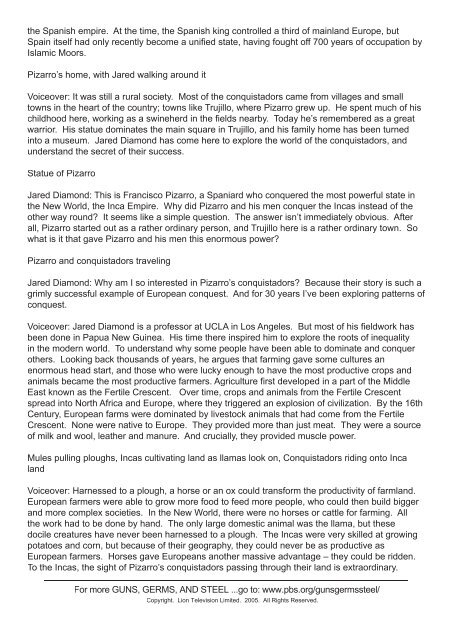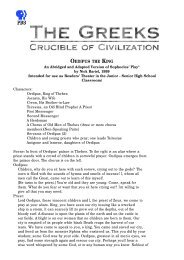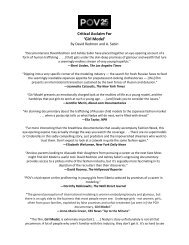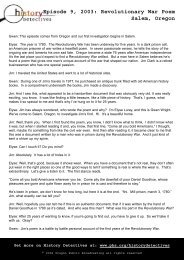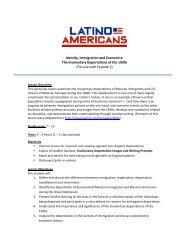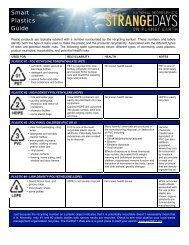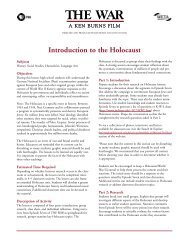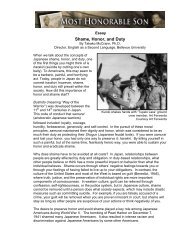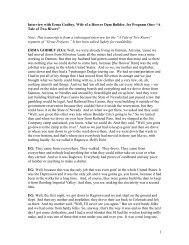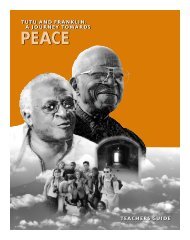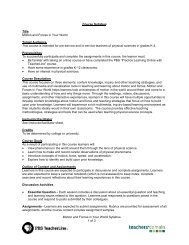Guns, Germs, and Steel - Transcript Episode 2: Conquest - PBS
Guns, Germs, and Steel - Transcript Episode 2: Conquest - PBS
Guns, Germs, and Steel - Transcript Episode 2: Conquest - PBS
- No tags were found...
You also want an ePaper? Increase the reach of your titles
YUMPU automatically turns print PDFs into web optimized ePapers that Google loves.
the Spanish empire. At the time, the Spanish king controlled a third of mainl<strong>and</strong> Europe, butSpain itself had only recently become a unifi ed state, having fought off 700 years of occupation byIslamic Moors.Pizarro’s home, with Jared walking around itVoiceover: It was still a rural society. Most of the conquistadors came from villages <strong>and</strong> smalltowns in the heart of the country; towns like Trujillo, where Pizarro grew up. He spent much of hischildhood here, working as a swineherd in the fi elds nearby. Today he’s remembered as a greatwarrior. His statue dominates the main square in Trujillo, <strong>and</strong> his family home has been turnedinto a museum. Jared Diamond has come here to explore the world of the conquistadors, <strong>and</strong>underst<strong>and</strong> the secret of their success.Statue of PizarroJared Diamond: This is Francisco Pizarro, a Spaniard who conquered the most powerful state inthe New World, the Inca Empire. Why did Pizarro <strong>and</strong> his men conquer the Incas instead of theother way round? It seems like a simple question. The answer isn’t immediately obvious. Afterall, Pizarro started out as a rather ordinary person, <strong>and</strong> Trujillo here is a rather ordinary town. Sowhat is it that gave Pizarro <strong>and</strong> his men this enormous power?Pizarro <strong>and</strong> conquistadors travelingJared Diamond: Why am I so interested in Pizarro’s conquistadors? Because their story is such agrimly successful example of European conquest. And for 30 years I’ve been exploring patterns ofconquest.Voiceover: Jared Diamond is a professor at UCLA in Los Angeles. But most of his fi eldwork hasbeen done in Papua New Guinea. His time there inspired him to explore the roots of inequalityin the modern world. To underst<strong>and</strong> why some people have been able to dominate <strong>and</strong> conquerothers. Looking back thous<strong>and</strong>s of years, he argues that farming gave some cultures anenormous head start, <strong>and</strong> those who were lucky enough to have the most productive crops <strong>and</strong>animals became the most productive farmers. Agriculture fi rst developed in a part of the MiddleEast known as the Fertile Crescent. Over time, crops <strong>and</strong> animals from the Fertile Crescentspread into North Africa <strong>and</strong> Europe, where they triggered an explosion of civilization. By the 16thCentury, European farms were dominated by livestock animals that had come from the FertileCrescent. None were native to Europe. They provided more than just meat. They were a sourceof milk <strong>and</strong> wool, leather <strong>and</strong> manure. And crucially, they provided muscle power.Mules pulling ploughs, Incas cultivating l<strong>and</strong> as llamas look on, Conquistadors riding onto Incal<strong>and</strong>Voiceover: Harnessed to a plough, a horse or an ox could transform the productivity of farml<strong>and</strong>.European farmers were able to grow more food to feed more people, who could then build bigger<strong>and</strong> more complex societies. In the New World, there were no horses or cattle for farming. Allthe work had to be done by h<strong>and</strong>. The only large domestic animal was the llama, but thesedocile creatures have never been harnessed to a plough. The Incas were very skilled at growingpotatoes <strong>and</strong> corn, but because of their geography, they could never be as productive asEuropean farmers. Horses gave Europeans another massive advantage – they could be ridden.To the Incas, the sight of Pizarro’s conquistadors passing through their l<strong>and</strong> is extraordinary.For more GUNS, GERMS, AND STEEL ...go to: www.pbs.org/gunsgermssteel/Copyright. Lion Television Limited. 2005. All Rights Reserved.


